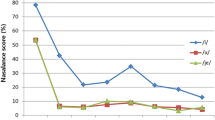Abstract
Rehabilitation of speech is tantamount to closure of defect in cases with velopharyngeal insufficiency. Often the importance of speech therapy is sidelined during the fabrication of obturators. Usually the speech part is taken up only at a later stage and is relegated entirely to a speech therapist without the active involvement of the prosthodontist. The article suggests a protocol for speech therapy in such cases to be done in unison with a prosthodontist.
Similar content being viewed by others
Explore related subjects
Discover the latest articles and news from researchers in related subjects, suggested using machine learning.References
Plank DM, Weinberg B, Chalian VA (1981) Evaluation of speech following prosthetic obuturation of surgically acquired maxillary defects. J Prosthet Dent 45(6):626–638
Yoshida H, Michi K, Ohsawa T (1990) Prosthetic treatment for speech disorder due to surgically acquired maxillary defects. J Oral Rehabil 17(6):565–571
Sullivan M, Gaebler C, Beukelman D, Mahanna G, Marshall J, Lydiatt D et al (2002) Impact of palatal prosthodontic intervention on communication performance of patient’s maxillectomy defects: a multilevel outcome study. Head Neck 24(6):530–538
Persson C, Elander A, Zohmander-Agerskov A et al (2002) Speech outcome in isolated cleft palate: impact of cleft extend and additional malformations. Cleft Palate Craniofac J 39:397
Kummer AW (2007) Resonance disorders & velopharyngeal dysfunction: simple low-tech and no-tech procedures for evaluation and treatment. ASHA Fellow
Kummer A (2006) Resonance disorders and nasal emissions: evaluation and treatment using “low tech” and “no tech” procedures. The ASHA Leader
Turner HE, Williams WN (1991) Fluoroscopy and nasoendoscopy in designing palatal lift prostheses. J Prosthet Dent 66:63–71
Skolnick ML (1970) Videofluoroscopic examination of the velopharyngeal port during phonation in lateral and base projections—a new technique for studying the mechanics of closure. Cleft Palate J 7:803–816
De Buys Roessingh AS, Cherpillod J, Trichet-Zbinden C, Hohlfeld J (2006) Speech outcome after cranial-based pharyngeal flap in children born with total cleft, cleft palate, or primary velopharyngeal insufficiency. J Oral Maxillofac Surg 64:1736–1742
Beumer J, Curtis TA, Marunick MT (1996) Maxillofacial rehabilitation: surgical and prosthodontic considerations, 1st edn. Ishiyaku Euroamerica, St. Louis
Author information
Authors and Affiliations
Corresponding author
Rights and permissions
About this article
Cite this article
Shyammohan, A., Sreenivasulu, D. Speech Therapy with Obturator. J Indian Prosthodont Soc 10, 197–199 (2010). https://doi.org/10.1007/s13191-011-0044-2
Received:
Accepted:
Published:
Issue Date:
DOI: https://doi.org/10.1007/s13191-011-0044-2




